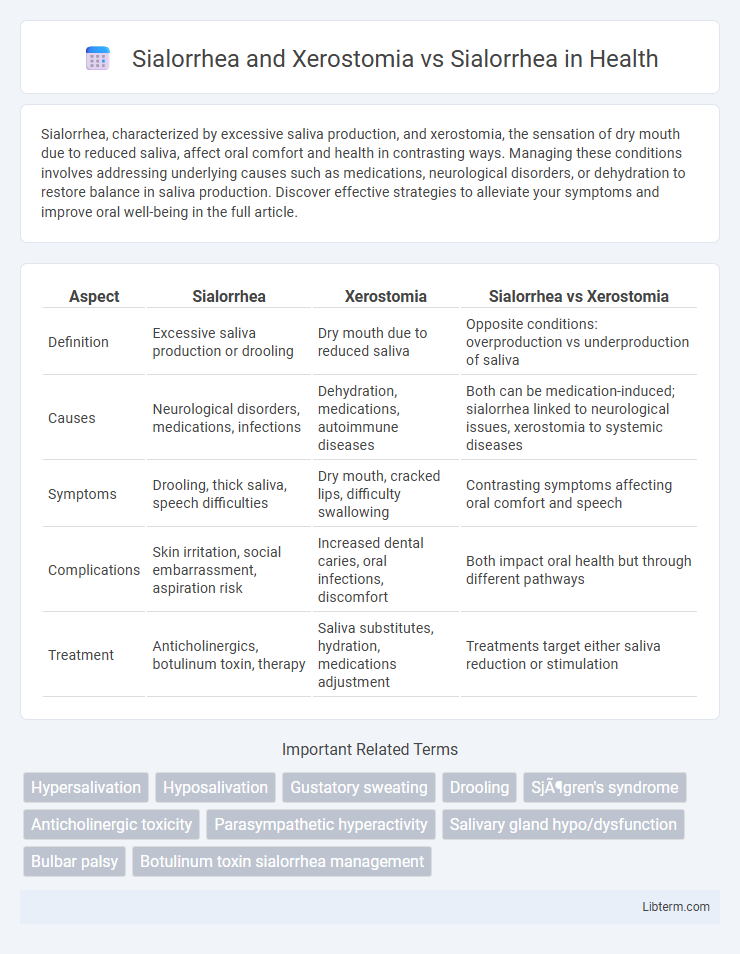Sialorrhea, characterized by excessive saliva production, and xerostomia, the sensation of dry mouth due to reduced saliva, affect oral comfort and health in contrasting ways. Managing these conditions involves addressing underlying causes such as medications, neurological disorders, or dehydration to restore balance in saliva production. Discover effective strategies to alleviate your symptoms and improve oral well-being in the full article.
Table of Comparison
| Aspect | Sialorrhea | Xerostomia | Sialorrhea vs Xerostomia |
|---|---|---|---|
| Definition | Excessive saliva production or drooling | Dry mouth due to reduced saliva | Opposite conditions: overproduction vs underproduction of saliva |
| Causes | Neurological disorders, medications, infections | Dehydration, medications, autoimmune diseases | Both can be medication-induced; sialorrhea linked to neurological issues, xerostomia to systemic diseases |
| Symptoms | Drooling, thick saliva, speech difficulties | Dry mouth, cracked lips, difficulty swallowing | Contrasting symptoms affecting oral comfort and speech |
| Complications | Skin irritation, social embarrassment, aspiration risk | Increased dental caries, oral infections, discomfort | Both impact oral health but through different pathways |
| Treatment | Anticholinergics, botulinum toxin, therapy | Saliva substitutes, hydration, medications adjustment | Treatments target either saliva reduction or stimulation |
Understanding Sialorrhea: Definition and Causes
Sialorrhea, also known as hypersalivation, is characterized by excessive saliva production often caused by neurological disorders, medications, or oral infections, unlike xerostomia, which is characterized by dry mouth due to reduced saliva. Understanding sialorrhea involves recognizing conditions such as Parkinson's disease, amyotrophic lateral sclerosis (ALS), or side effects of antipsychotic drugs that impair swallowing or saliva control, leading to drooling. Accurate diagnosis requires differentiating between increased saliva production and impaired clearance to guide effective treatment strategies.
Xerostomia Explained: What Is Dry Mouth?
Xerostomia, commonly known as dry mouth, results from reduced saliva production, leading to difficulties in speaking, swallowing, and increased dental decay risk. Unlike sialorrhea, which is characterized by excessive saliva flow or drooling, xerostomia often stems from medication side effects, autoimmune diseases like Sjogren's syndrome, or radiation therapy. Effective management of xerostomia involves saliva substitutes, good oral hygiene, and addressing underlying causes to improve patient quality of life.
Key Differences Between Sialorrhea and Xerostomia
Sialorrhea is characterized by excessive saliva production leading to drooling, while xerostomia refers to the subjective sensation of dry mouth due to reduced saliva secretion. The key difference lies in saliva quantity: sialorrhea involves hypersalivation, whereas xerostomia involves hyposalivation or impaired saliva flow. These conditions also differ in etiology, with sialorrhea often linked to neurological disorders and xerostomia commonly caused by medications, radiation therapy, or systemic diseases like Sjogren's syndrome.
Shared Symptoms of Sialorrhea and Xerostomia
Sialorrhea and xerostomia both involve disruptions in salivary gland function, leading to abnormal saliva consistency and oral discomfort. Shared symptoms include difficulties with swallowing, speech impairment, and increased risk of oral infections due to altered saliva production. Both conditions can contribute to mucosal irritation and impact overall oral health, despite sialorrhea causing excessive saliva and xerostomia signifying dryness.
Medical Conditions Linked to Sialorrhea
Sialorrhea, characterized by excessive saliva production or impaired clearance, is commonly linked to neurological disorders such as Parkinson's disease, cerebral palsy, and stroke, which disrupt normal swallowing mechanisms. Xerostomia, or dry mouth, differs as it involves reduced saliva secretion often caused by medications, Sjogren's syndrome, or radiation therapy, leading to discomfort and oral health complications but not typically excessive drooling. Understanding these medical conditions is critical for appropriate management and treatment strategies targeting either the overproduction or insufficient production of saliva.
Xerostomia: Common Triggers and Risk Factors
Xerostomia, commonly triggered by medications, autoimmune diseases like Sjogren's syndrome, and radiation therapy to the head and neck, results in reduced saliva production and a dry mouth sensation. Risk factors include aging, dehydration, smoking, and certain chronic conditions such as diabetes and Parkinson's disease. Unlike sialorrhea, which involves excessive saliva production or drooling, xerostomia primarily affects oral health by increasing the risk of dental caries, oral infections, and difficulties in speaking and swallowing.
Diagnosis: Differentiating Sialorrhea from Xerostomia
Differentiating sialorrhea from xerostomia involves assessing salivary flow rates and patient-reported symptoms to accurately diagnose the underlying disorder. Sialorrhea is characterized by excessive saliva production and drooling, often confirmed through quantitative sialometry, whereas xerostomia is defined by subjective dry mouth sensations despite potentially normal or reduced saliva output. Clinical evaluation may include oral examination, patient history, and salivary gland imaging or scintigraphy to distinguish hypersecretion from hypofunction or altered saliva consistency.
Treatment Approaches for Sialorrhea
Treatment approaches for sialorrhea primarily focus on reducing saliva production and managing symptoms to improve patient quality of life. Options include anticholinergic medications such as glycopyrrolate, botulinum toxin injections targeting salivary glands, and in severe cases, surgical interventions like salivary gland excision or duct ligation. Unlike xerostomia, which requires treatments to stimulate saliva production and maintain oral moisture, sialorrhea treatment emphasizes decreasing excessive salivation through pharmacological and procedural methods.
Managing Xerostomia: Effective Therapies
Managing xerostomia, characterized by dry mouth due to decreased saliva production, involves therapies such as saliva substitutes, pilocarpine, and cevimeline to stimulate salivary flow, improving oral comfort and reducing complications like dental caries. Unlike sialorrhea, which is excessive saliva production often treated with anticholinergic medications or botulinum toxin injections, xerostomia management prioritizes hydration and mucosal lubrication to restore oral moisture balance. Effective xerostomia treatment reduces risks of oral infections, enhances taste sensation, and supports overall oral health.
Patient Quality of Life: Sialorrhea vs. Xerostomia
Sialorrhea causes excessive saliva that leads to social embarrassment, skin irritation, and difficulties in speech and swallowing, significantly impairing patient quality of life. Xerostomia, characterized by dry mouth due to reduced saliva production, results in oral discomfort, increased risk of dental caries, and challenges in speaking and eating, which also severely affect daily living. Both conditions disrupt oral health and social interactions, requiring tailored management strategies to improve patient well-being.
Sialorrhea and Xerostomia Infographic

 libterm.com
libterm.com